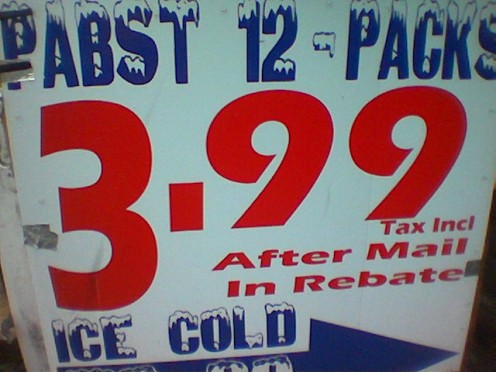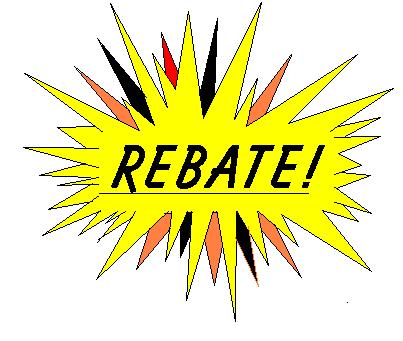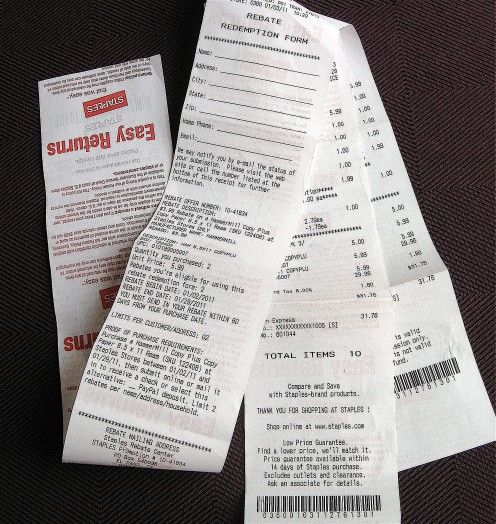Mail In Rebate! ... or NOT! Why You Should Think Twice Before Buying With a Rebate

Wait! Before you buy that item with a rebate, think again. Will you really mail in that rebate form? Or is it just your good intentions to mail it, intentions likely to go astray in the daily detritus of living? Lay that rebate slip on your desk or table. And before you know it—today’s mail, then yesterday’s mail all pile on top of it, and Voila!...out of sight, out of mind....and it's forgotten.
Take a closer look at how your mind works.
It may be that you're simply rationalizing the purchase of something you want, but that really doesn't fit your budget. Should you buy it? Hm-mm, that rebate sure makes it hard to pass up. See how much you'll save! And you imagine having that savings right now. And there it goes, tipping the balance, and—against your better judgment—you make the purchase.
But say it does fit into your budget. Not at the full price, you're figuring on the after-rebate price, right? Now is the time to get real. Look at the item again. If you’re willing to pay the price before the rebate, I say, go ahead and buy it. Otherwise, please read this article first!

Research Shows
40 to 60% of rebates are never mailed at all! Okay, so you are quite certain that you will actually claim your rebate. Really? Maybe so. But look back, and chances are you will remember a time you forgot to mail it in.

One story - minor item
We recently purchased printer paper at Staples, regular price $5.99. With the mail-in rebate of $3.99, the price was just $2.00 each. Good deal, right? We bought two, counting up savings of $8. Knowing that I sometimes forget to follow up, I immediately went home, sat down and filled out the rebate redemption form.
I was amazed at the length of the receipt and rebate form. I had to measure it. 72 inches long, that’s 6 feet. This for a $7.98 rebate. And I had to read it all to figure out how it worked. The form was easy to fill out. But the terms and conditions were 39 lines long. At the end it said, "You should receive your rebate within 4-6 weeks."
Well, here's the true story: After mailing the rebate form, I set my copy in my "to do" pile to remind myself to check on it. And, well, it's not 6 weeks later, but more like 5 months later. At this point, I can't remember whether I got the rebate of not. For purposes of this article, I called the number on the sales receipt, and Yes! it gave the date and amount of the refund. I just forgot to pull out the slip I saved as a reminder and throw it away.
So that story had a happy ending. But it doesn't always work out that way.

Bigger story: TiVo
Remember, 40 to 60% of all rebate offers are never redeemed at all. This from industry surveys...so keep in mind, stores are counting on the fact that at least half the time you are not going to mail in that rebate. That way they make more money. The rebate offer gives you the idea that you are saving money. You get to enjoy the purchase. And no one's the wiser. But, if you think about it, we the consumer have just been duped. By our own wishful thinking!
We're not just talking about $2 printer paper, either. TiVo, for example...Business Week reported that in one year, nearly half of the 100,000 new TiVo subscribers never redeemed their $100 rebate. That saved the company and cost the consumer $5 million dollars!
You'd think a $100 rebate would be very motivating and buyers would make sure to redeem the offer. It ain't necessarily so.
Another story.............. Book-Of-The-Month Club
One of the most famous mail back companies is the Book-Of-The-Month Club. It's technically not a mail-in rebate company, but it will serve us well as an example. The same principals apply, and we can see the psychological mechanisms at work.
No question the BOMC has been successful. They started in 1926 and are still going strong, even keeping up with the times by adding an online version called BOMC2.
Sign up, you get a bunch of free books, all you have to do is buy two in the next two years. Easy enough, right? Oh, and you'll also get the opportunity to buy the monthly book selection or other books at member prices. If you don't want any books, all you have to do, mark the order coupon and mail it back. Oh, and mail it back before the deadline. Otherwise, you will automatically receive that month's selection.
And that might go on for months and months. You got your free books up front, you figure you'll buy a book a year for someone's birthday. Except....oops! forgot to mail back that @*%X#! coupon. Which you didn't even realize until you receive...you guess it! there's the monthly selection in your mailbox.
SAVE MONEY! MAIL-IN REBATE! BUYER BEWARE!

Unfortunately, the stores and mail order companies are counting on your not redeeming according to the rules. Ever had a gift certificate that expired, so you just shrugged and threw it away? They were counting on it. Ever pay $10 for a $20 coupon on Groupon and never redeemed it? They were counting on it.
I'm not saying these companies are defrauding you. They are not. What they are doing is perfectly legal. They are just using human nature to their advantage. And you and I, the consumers, are the ones with the empty pockets.
Yes, the stores are counting on the fact that 40 to 60% of the time, consumers will not make the claim. They even have a word for it "breakage" also know as the shoebox effect. They even have a slightly different word when a consumer receives a rebate, but they lose or forget to cash the check! It's called "slippage." I can assure you, they are counting on it.
You do the work...they keep the information
Try another way to look at it. Rebates take a certain amount of effort and time - read the rules, fill out the form, prepare and mail it, cash or deposit the check, and keep track of the paperwork.
You might think of the rebate as paying you to do the paperwork, and they get to use your personal data! Unless they say they won't, they probably will sell your information to other marketing companies.
And finally, you might not complete the form accurately, or it gets lost somewhere in the process, further reducing your odds of cash back.

On the other hand...
Marketing company Parago, a consumer incentives and rebate provider, which handles rebates for Staples and other company, says that the typical American household that takes advantage of consumer rebates saves an average of $150 annually.
Hm-mm, I've only save $7.98, but maybe so. So, how can you benefit from this bargain bonanza, without running the risks of falling into the 40 to 60% who fail to redeem?
Here are some tips to help:
- If you buy an item with a rebate, promise yourself you will complete what’s required and submit it that very same day. Then do it.
- Make a copy of what you submit with the date and method of submission.
- Mark your calendar—the rebate will tell you how long it can take, often 6–8 weeks, so mark your calendar, after about 8 weeks.
-
Promise yourself you will take action immediately if you haven’t received the rebate by the time that date rolls around. Then be sure to do it.
-
When you do get your rebate, flip forward to remove the 8-week reminder. Otherwise, you may forget and 8 weeks later be scratching your head, “Now did I receive that rebate or not?”
Rebates Everywhere
You will find mail-in rebate offers on practically every kind of merchandise....coffee makers, athletic shoes, cameras, air conditioners, electronics, car radios...to name a few. Just Google "Rebates" for a start. Or your specific interest, such as "TV Rebates".
HAPPY SHOPPING!









